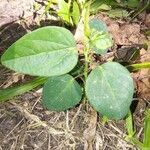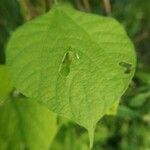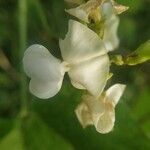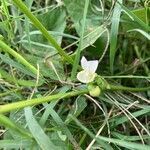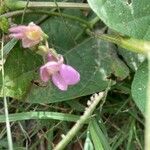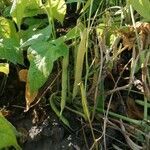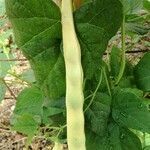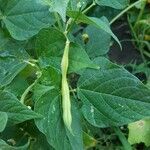Climbing or trailing vine or erect herb; stems glabrous or pubescent. Leaves pinnate trifoliolate, the leaflets mostly ovate, sometimes broad, the lateral leaflets mostly oblique; glabrate to velutinous, apically acute, or acuminate, the petiolules 2-4 mm long, stout, pubescent; petioles often exceeding the terminal leaflet; stipels linear, costate, glabrous, as long as or shorter than the petiolules; stipules lanceolate, striate, glabrous. Inflorescences axillary, mostly 3-10 cm long; pe-duncle mostly slender and weak; rachis contracted; bracteoles and bracts spa-thaceous, exceeding the calyx, striate; pedicels slender. Flowers white, yellowish or purplish; calyx campanulate, the teeth rounded; standard 1-2 cm long. Legume linear, turgid, often slightly curved, glabrate, mostly 10-20 cm long; seeds sub-globose to oblong, to 1.5 cm long, variously colored.
This bean has very many varieties and varies a lot in details. Both short and climbing cultivated varieties of this bean occur. It has a long taproot. Climbing forms can be 2-3 m tall. Bush types are 20-60 cm tall. The leaves are carried one after another along the stem and the leaves have 3 leaflets. The leaf stalk has a groove on the top. The side leaflets are asymmetrical in shape. The leaflets can be 8-15 cm by 5-10 cm. The flowers are in the axils of leaves and have few flowers in a loose form. Flowers are white to purple and pods smooth. Pods are slender and 8-20 cm long by 1-1.5 cm wide. The pods are straight or slightly curved and with a beak at the end. Pods often have 10-12 seeds which are kidney shaped and coloured. There are more than 500 cultivated varieties.
Annual herbs, twining or suberect. Stems pubescent or glabrescent when old. Stipules lanceolate, ca. 4 mm; leaflets broadly ovate or obovate-rhombic, lateral ones oblique, 4-16 × 2.5-11 cm, pubescent, base rounded or broadly cuneate, margin entire, apex acuminate. Racemes shorter than leaves, usually several flowered at top of rachis. Bracteoles ovate, usually as long as calyx or slightly longer, persistent. Calyx cup-shaped, 3-4 mm, upper lip emarginate. Corolla white, yellow, violet, or red; standard 9-12 mm wide; wings obovate; keel ca. 1 cm, apex spirally twisted. Ovary pubescent. Legumes linear-oblong, 10-15 × 1-1.5 cm, slightly curved and turgid, glabrous, beaked. Seeds 4-10, white, brown, blue, or variegated, oblong or ensiform, 0.9-2 × 0.3-1.2 cm. Fl. Apr-Jul.
Leaflets 3, 4.5–15 × 2.5–6.5 cm, ovate or ovate-rhombic, the laterals oblique, all leaflets acuminate, ± rounded at the base, pubescent; petiole 4–9 cm long; rhachis 10–24 mm long; petiolules 1.5–2.5 mm long; stipules 4 mm long, lanceolate, ribbed.
Inflorescences 1–3-flowered or flowers solitary, shorter than the leaves; peduncles 0–5 cm long; pedicels 3–10 mm long; bracts 3 mm long, ovate; bracteoles conspicuous, 5–6 × 2.5–3.5 mm, ovate-lanceolate, conspicuously veined.
Two cult. spp., P. vulgaris L., the common bean, and P. coccineus L., the scarlet runner, occasionally escape but apparently never persist.
Pods 11–12.5(20) × 1–1.3 cm, linear-lanceolate, (5)10–12-seeded (sometimes fewer by abortion), compressed, beaked, puberulous or glabrous.
Calyx puberulous; tube 2–3 mm long; lobes c. 1 mm long, the upper pair joined to form a slightly emarginate lip.
Standard 1(19) × 11 mm, oblate-oblong, glabrous; keel c. 22 mm long, spirally incurved.
Seeds 9–20 × 3–12 × 4–11 mm, oblong-ellipsoid or reniform, compressed.
Corolla white, yellowish, purple or dark or pale pink.
Annual climber or suberect herb 0.2–several m tall.
Stems glabrescent or pubescent.

